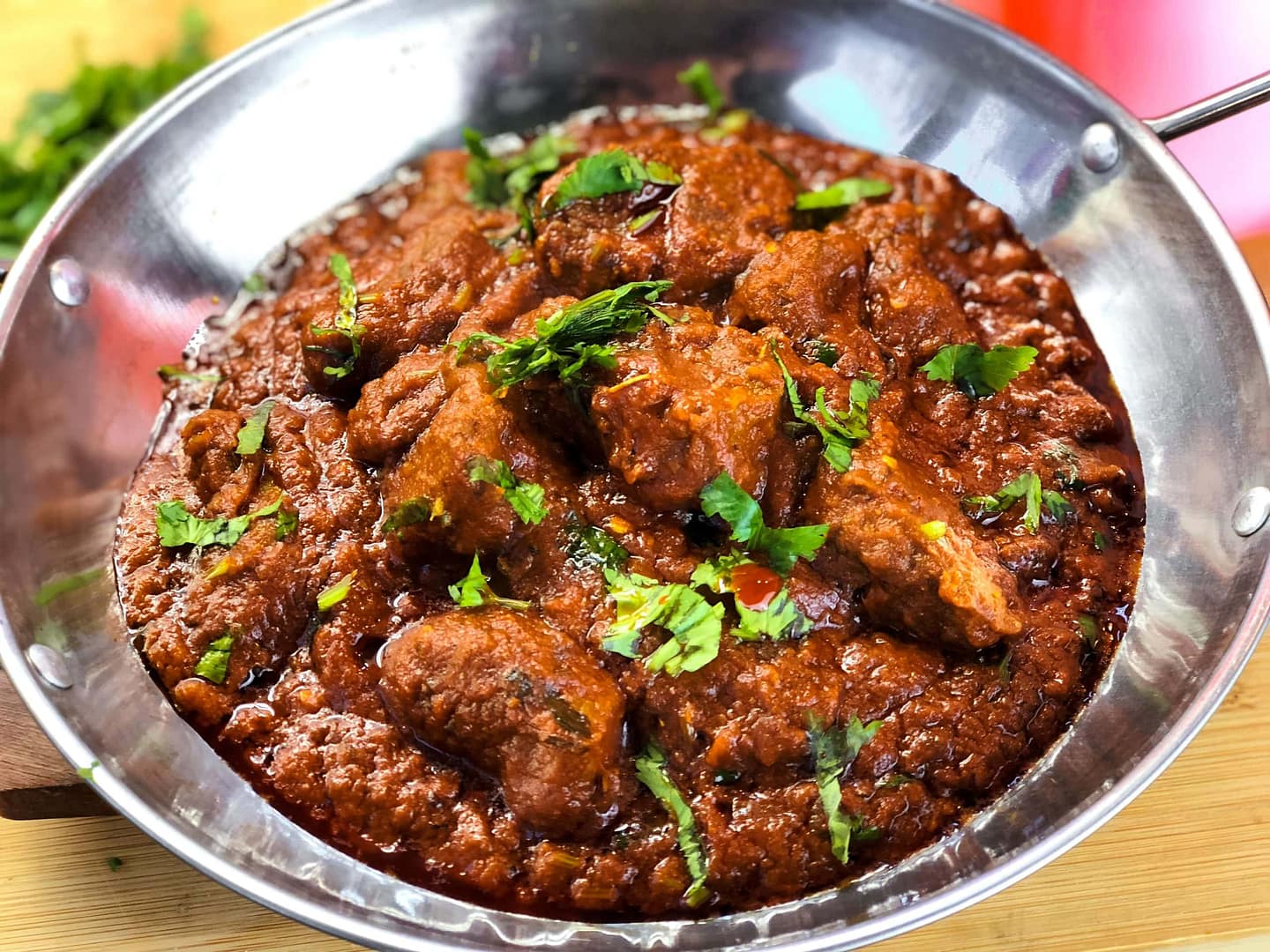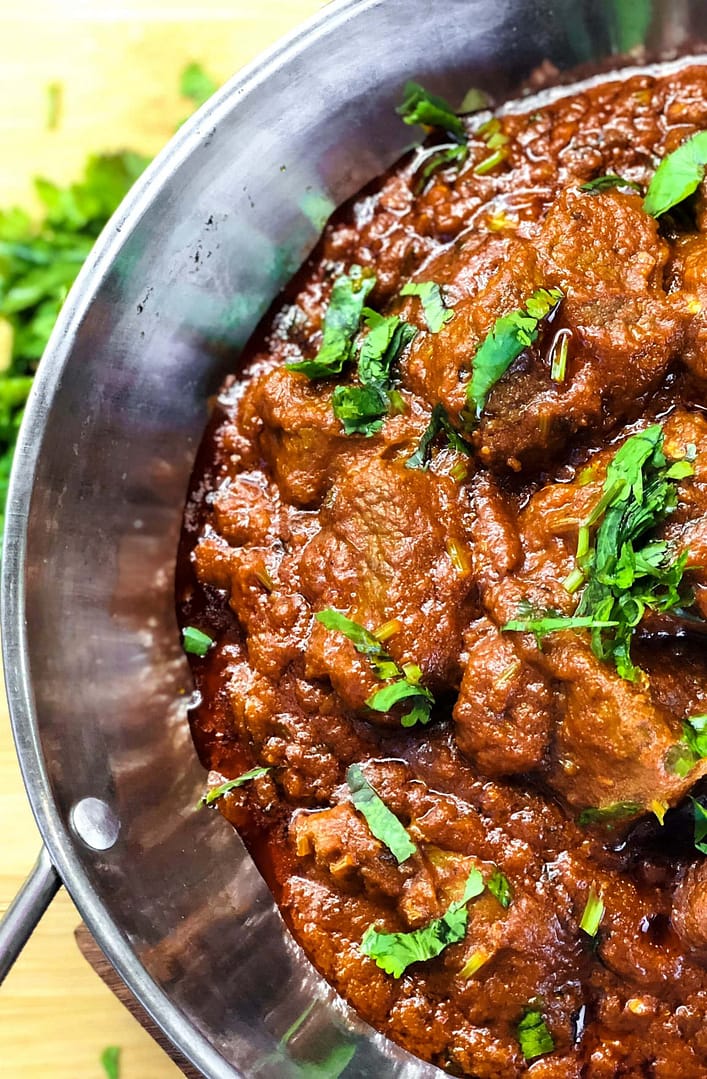The famous and usually excruciatingly hot phaal is a curry to be handled with extreme caution.
There are some hotter curries out there (as always), but my recipe holds back no punches, so if you like the idea of being proverbially slapped in the face with a red-hot poker, give this one a try. Don’t be fooled by the level of spice though, this curry has lots of flavour.
Any main ingredient of your choice can be used, for example, chicken tikka, pre-cooked chicken, pre-cooked lamb (pictured) or beef, prawns, vegetables, paneer, and so on.
Feeds 1-2 foolhardy people. The recipe one of many in my first award-winning book, Indian Restaurant Curry at Home Volume 1.
INGREDIENTS
- 5 TBSP (75ml) Oil
- 1 tsp Fennel Seeds
- 1 TBSP Ginger/Garlic Paste
- 1 tsp Kasuri Methi
- 1 TBSP Extra Hot Chilli Powder
- 2 TBSP Kashmiri Chilli Powder
- 1 TBSP Chilli Flakes
- 1 TBSP Chilli Chutney or Pickle
(e.g. Mr Naga) - 2 tsp Mix Powder
- ¼ tsp Garam Masala
- ¼-½ tsp Salt
- 7 TBSP Tomato Paste
- 1 TBSP each of fresh Coriander Stalks
and Leaves, finely chopped - 330ml+ Base Gravy, heated up
- Pre-Cooked Chicken, Lamb, Beef,
Vegetables, etc. - 2 tsp Lemon Juice
- 2 tsp Sugar (optional)
METHOD
- Add the oil to a frying pan on medium high heat.
- When hot add the fennel seeds and fry for 30-45 seconds to infuse the oil with flavour.
- Then add the ginger/garlic paste and fry for 20-30 seconds, until starting to brown and the sizzling sound lessens, meaning the water content has evaporated and the rawness is cooked out.
- Add the kasuri methi, mix powder, extra hot chilli powder, Kashmiri chilli powder, chilli flakes, chilli chutney/pickle, garam masala, salt, and add a splash of base gravy to help mix the spices and prevent burning.
- Fry for 40-50 seconds, stirring constantly and ensuring flat distribution of the spices in the pan. If the spices show signs of starting to stick to the pan and burn, add a little extra base gravy or water to loosen things up. There are a lot of powdered spices in this phaal curry, and it’s very important to allow enough time to cook the chilli powders out properly. If they are not cooked out sufficiently, the curry will taste harsh and bitter, not to mention give you undesired ‘after effects’.
- Turn up the heat to high and pour in the tomato paste. Fry for a further 30-45 seconds while stirring constantly until the oil separates and small craters appear around the edges of the pan.
SPACEHOLDER
- Now add the pre-cooked chicken tikka, lamb, vegetables, etc., and the 1 TBSP of coriander stalks.
- Then add the first 75ml of base gravy. Mix the contents of the pan together well and leave to cook until the sauce has reduced a little, oil separation has occurred, and small craters form once again.
- Add a second 75ml of base gravy, stirring and scraping the bottom and sides of the pan once when first added, allowing the sauce to reduce again.
- Then add 150ml of base gravy, the lemon juice, and sugar (optional – add to taste). Stir and scrape the bottom and sides of the pan once, then leave to cook for 4-5 minutes. Avoid fiddling unless the curry shows signs of starting to burn, and add extra base gravy if desired to thin the sauce out. Taste the curry and cook for longer if evident that the chilli powders have not cooked out enough.
- There should be a lot of excess oil on the surface. Spoon it off from the top of the curry if you are health conscious.
- Serve, sprinkling the finely chopped coriander leaves on top.
NOTES
- The sugar is optional, but I find it helps to round off the heat from the massive amount of chilli powders.
- Caution is advised when cooking this phaal. Ensure extractor fans in the kitchen are turned on full, and windows are open. Wearing a mask and gloves is advised.
- The author of this recipe accepts no responsibility for the physical or mental effects that eating this phaal will have.
- All spoon measurements are level. 1 tsp=5ml. 1 TBSP=15ml
Watch the Video
2 Comments
Submit a Comment
You must be logged in to post a comment.







What kind of chilli flakes do you use?
I just use standard shop-bought ones. I don’t use them a lot in my recipes so I’m not too fussy.